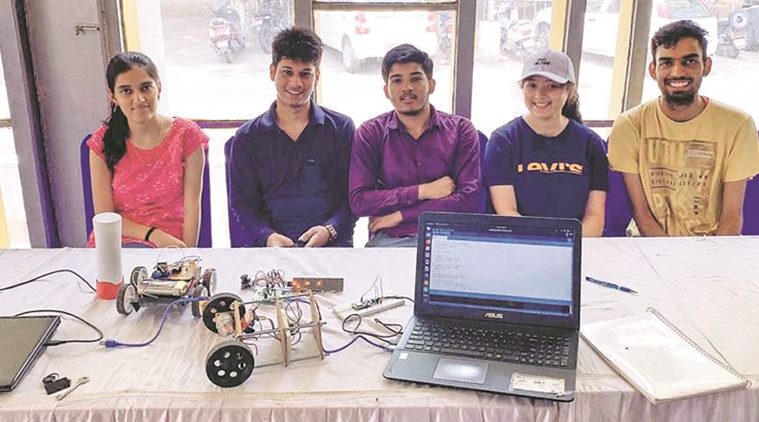Students from University of Engineering and Technology, Panjab Univerity Chandigarh showcased their models in an exhibition by Design and Innovation Centre, UIET in Law Auditorium on Saturday.
Written by Vrinda Gupta
The world of technology, while vast and baffling to some, buries its roots in the minds of a choice few and sows the seeds of invention. Students from University of Engineering and Technology, Panjab Univerity Chandigarh showcased their models in an exhibition by Design and Innovation Centre, UIET in Law Auditorium on Saturday. The youth of the city is coming up with new contraptions to ease our lives, and here we take a look at some who’re poised to be harbingers of a new era.
The winds of change
Divyadeep Singh from Mechanical Engineering has revolutionized the ubiquitous wind turbine by creating a prototype of a vertical axis wind turbine for the purpose of energy generation. “What’s new is that the blades used in this model are lightweight and have been constructed in a way that they can produce high RPM even at low wind speeds,” he says. The second titration involves another prototype which can be installed on top of the model and can make a hybrid configuration.
“This is a five-times scaled down model. The actual model will be capable of producing 1 kW of power at wind speeds of 5m/s. The vertical turbines can produce power independent of wind direction – unlike horizontal ones that have to be facing particular direction depending on the wind.”
Switch it up
Manik Dalal, Abhinav, Arnav Sharma from Electrical and Electronics Engineering (EEE) got in the nitty-gritty of electrical setups in homes and have made a smart switch. This switch can connect to a Bluetooth device and can be operated from a mobile phone. “Our switch is compact in size, and is based on the ‘one for one replacement’ model; you’ll replace one switch with our smart switch.” No expertise is required to install this switch and any electrician can do so, they claim. The trio tout this as extremely cost efficient, with one switch costing as less as Rs 15. “No infrastructural modification is required to use these. We aim to popularize them in poor households.”
Wheels of success
With his PC-controlled automated car, Vijay Kumar from EEE has ambitious plans for his project. He has used the programming language Python to integrate a PC with a micro-controller present in the car. “Once a piece of code runs, external manipulation is not possible. But we bypass this problem by using Python; the car can be controlled with the help of the computer. In fact, using this technology we can exercise control over any vehicle from anywhere, provided we have an internet/satellite connection,” he says. The device can be used for disaster management, as it can be sent out to affected areas to scout for people. “The feature of the live camera feed also reduces the risk posed to search parties who can survey the area they’re planning to go to.” Kumar also says there is a possibility his model can have an impact on space research and be used to control the movement of a device on the moon.
Taking stock
Pranav Kumar, Charvi Mendiratta, Ankur Bhatia, and Dhawal Sharda from Electronics and Communication Engineering have found a way to make warehousing more efficient by automating the entire process. “A major chunk of transporting objects is still done manually. We have applied image processing to our device that will detect objects, based on their types. It will then proceed to pick the object(s), stack them if required, and follow a pre-defined path to transport them to a different part of the warehouse,” they explain. The confined space makes the project feasible, unlike roads where moving vehicles pose as unpredictable obstacles. “We’ve developed our own algorithm for this which works using multiple threading. The device will help reduce labour costs.”
Flying to new heights
Prayag Sharma, Kapil Kumar, Kishitiz Goyal from EEE and Computer Science Engineering are proud creators of two fully autonomous drones that are GPS controlled and require no manual interference. “One of our drones is capable of lifting 1.5 kg of payload, while the other is equipped with two compasses implying more flight stability. We’ve already successfully tested a flight with 1 kg payload – right from take-off to touchdown.” The drones are also fitted with a camera that can be put to use in myriad ways. “We can extract data from images that tell whether the object captured is a vehicle, human, etc. So, for instance, in a huge parking lot, the drone will not only be able to count the vehicles parked, but also be able to identity them.”
The sound of science
Perhaps the flashiest project of the day is attributed to Sahil Sharma from EEE. His invention is a sound-reactive RGB LED lamp. The lamp comes with a microphone and can sense external disturbances. It glows in accordance with the intensity of the sound and also has the ability to change colors using a phone. The model, however, is more than just smoke and mirrors. The prototype has the potential to be used in technologies designed for people who’re hearing impaired. “The lamp can help them detect disturbances in the room/house, and can also warn of burglars.” Even an act as simple as someone hollering for the person from another part of the house can become easier with this lamp.
Source: Read Full Article


